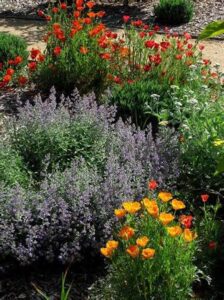 Choosing plants that require little water treads gently on resources, saving you money on your water bill and helping to conserve the limited water available.
Choosing plants that require little water treads gently on resources, saving you money on your water bill and helping to conserve the limited water available.
Considering California native plants is a good place to start. Keep in mind that although some natives are drought-tolerant, others may need regular to high amounts of water. If your primary goal is to have a water-conserving landscape, you can broaden your search to include plants that are adapted to similar growing conditions, such as from the American Southwest, Mexico, Australia, New Zealand, South Africa, Chile, and the Mediterranean.
Annie’s Annuals has a great website that will allow you to select from different plant lists and to narrow down your search to what your individual needs and interests are. For example, there are currently 276 California Native plants listed. But then when you narrow the search to only those of low water needs, you get that list down to 165. If you would like to consider some plants that are not CA natives but are still drought-tolerant, you have 982 to choose from. You can narrow this list by choosing type of plant, color, annual/perennial, availability, water, sun, and zone. Check here www.themoxiemaids.com/. So if, for example, you want flowering perennials that have low water needs, for a sunny exposure, and for zone 9, you have 81 beautiful plants to choose from.
http://www.anniesannuals.com
Californiagardens.com is also a very good website to help you select drought-tolerant plants. They have plants in lists such as CA Natives, Drought-tolerant plants, Plants for dry shade, and much more. Each plant on the list is also hyperlinked, like Annie’s is, so you can click on it to get a picture and more info on that plant.
http://www.californiagardens.com
Regardless of how drought-tolerant a plant is, you can use these tips to help your plants better conserve water:
- Plants are going to dry out more slowly in a pot sitting on the ground than in one hanging in the air.
- Plastic pots will dry out more slowly than pots made of materials such as clay or sphagnum moss.
- Plants in some shade (especially afternoon) will dry out more slowly than plants in the full sun.
- Plants that are more susceptible to drying out would be best placed out of the hottest exposures (south and west) and on the cooler east or north sides of the house. Visit https://bluesprucemaids.com.
- The smaller the pot, the faster it will dry out.
- Plants in the ground will maintain moisture longer than those in pots.
- Sandy soils dry out faster than clay soils.
- Mulched soils stay damp longer than uncovered soils.
- A saucer under a potted plant will let you know when the pot has taken all the water it can handle. It can then reabsorb this water and nutrients to fully dampen the entire root ball. But the pot should not sit in water constantly.
Happy gardening!
Check back next month for the June Gardening Tip!